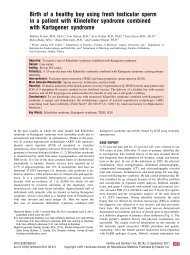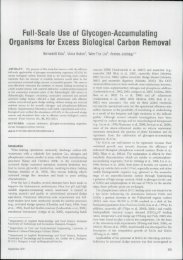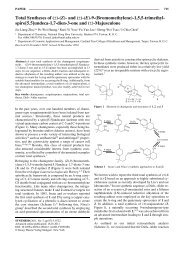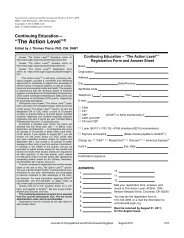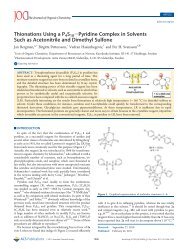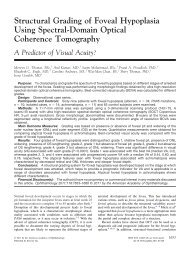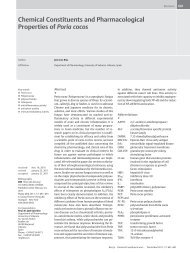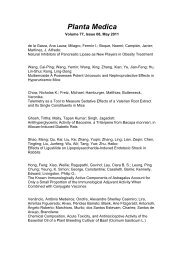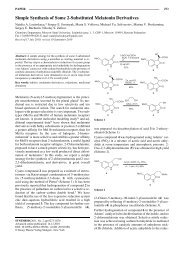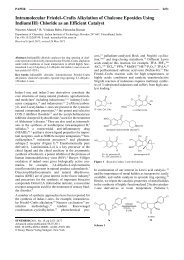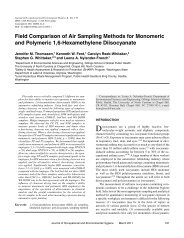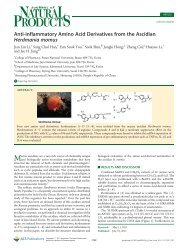National study of factors influencing assisted reproductive ...
National study of factors influencing assisted reproductive ...
National study of factors influencing assisted reproductive ...
Create successful ePaper yourself
Turn your PDF publications into a flip-book with our unique Google optimized e-Paper software.
<strong>National</strong> <strong>study</strong> <strong>of</strong> <strong>factors</strong> <strong>influencing</strong> <strong>assisted</strong><br />
<strong>reproductive</strong> technology outcomes with male factor<br />
infertility<br />
Ajay K. Nangia, M.B.B.S., a Barbara Luke, Sc.D., M.P.H., b James F. Smith, M.D., M.S., c<br />
Winifred Mak, M.D., Ph.D., d Judy E. Stern, Ph.D., e and the SART Writing Group<br />
a Department <strong>of</strong> Urology, University <strong>of</strong> Kansas Medical Center, Kansas City, Kansas; b Department <strong>of</strong> Urology, Michigan State<br />
University, East Lansing, Michigan; c Department <strong>of</strong> Urology, University <strong>of</strong> California, San Francisco, San Francisco, California;<br />
d Department <strong>of</strong> Obstetrics and Gynecology, University <strong>of</strong> Pennsylvania, Philadelphia, Pennsylvania; and e Department <strong>of</strong><br />
Obstetrics and Gynecology, Dartmouth-Hitchcock Medical Center, Lebanon, New Hampshire<br />
Objective: To evaluate the outcomes <strong>of</strong> <strong>assisted</strong> <strong>reproductive</strong> technology (ART) cycles for male factor infertility,<br />
and method <strong>of</strong> sperm collection.<br />
Design: Historic cohort <strong>study</strong>.<br />
Setting: Clinic-based data.<br />
Patients: Cycles from the Society for Assisted Reproductive Technology Clinic Outcomes Reporting System database<br />
for 2004 to 2008 were limited to three groups: non-intracytoplasmic sperm injection (ICSI) and ICSI cycles<br />
for tubal ligation only; non-ICSI and ICSI cycles for male factor infertility only; and all cycles (regardless <strong>of</strong><br />
infertility diagnosis) using ICSI only.<br />
Intervention(s) and Main Outcome Measure(s): Multivariate logistic regression was used to model the adjusted odds<br />
ratio (AOR) <strong>of</strong> clinical intrauterine gestation (CIG) and live birth (LB) rates for tubal ligation versus male factor infertility<br />
only; ICSI versus non-ICSI for male factor infertility only; and ICSI outcomes based on method <strong>of</strong> sperm collection.<br />
Result(s): Models for male factor infertility only versus tubal ligation only ICSI cycles had lower CIG (AOR 0.92)<br />
but not LB (AOR 0.87). No difference was seen for non-ICSI cycles. Within male factor infertility only cycles, ICSI<br />
had a worse outcome than non-ICSI for CIG (AOR 0.93) but not for LB (AOR 0.94). For all ICSI cycles with no<br />
male factor infertility and ejaculated sperm as the reference group, models showed better rates <strong>of</strong> CIG with male<br />
factor infertility ejaculated sperm (AOR 1.07) and with male factor infertility aspirated sperm (AOR 1.09). The LB<br />
rate was higher with male factor infertility ejaculated sperm only (AOR 1.04).<br />
Conclusion(s): The ICSI and sperm source influence CIG and LB rates in male factor infertility cases. (Fertil<br />
Steril Ò 2011;96:609–14. Ó2011 by American Society for Reproductive Medicine.)<br />
Key Words: SART, male factor infertility, ICSI, sperm collection methods<br />
At least 50% <strong>of</strong> infertility is partly or completely attributable to<br />
a male factor (1). A Centers for Disease Control and Prevention<br />
(CDC) <strong>study</strong> <strong>of</strong> men in the 2002 <strong>National</strong> Survey for Family Growth<br />
found that 7.5% <strong>of</strong> all sexually experienced men reported a visit for<br />
help with having a child at some time during their lifetime (equating<br />
to 3.3–4.7 million men) (2). Of men who sought help, 13.7% were<br />
diagnosed with a sperm or semen problem (2). Reduced fertilization<br />
rates, progression to blastocyst, pregnancy, and live birth outcomes<br />
from <strong>assisted</strong> <strong>reproductive</strong> technology (ART), especially intracytoplasmic<br />
sperm injection (ICSI), have been shown to be related to the<br />
severity <strong>of</strong> male factor infertility by individual groups but has not<br />
been studied at a national level (3–7). Similarly, the outcomes<br />
based on method <strong>of</strong> sperm acquisition have been limited and<br />
variable (8, 9). This is largely due to there being no formal<br />
standardized national database regarding the definitions and<br />
prevalence <strong>of</strong> male factor infertility or outcomes.<br />
Received April 17, 2011; revised June 8, 2011; accepted June 9, 2011;<br />
published online July 5, 2011.<br />
A.K.N. has nothing to disclose. B.L. has nothing to disclose. J.F.S. has<br />
nothing to disclose. W.M. has nothing to disclose. J.E.S. has nothing<br />
to disclose.<br />
Reprint requests: Ajay K. Nangia, M.B.B.S., Department <strong>of</strong> Urology, University<br />
<strong>of</strong> Kansas Medical Center, MS3016, 3901 Rainbow Boulevard,<br />
Kansas City, Kansas 66160 (E-mail: anangia@kumc.edu).<br />
At present databases based on insurance (e.g., Kaiser or Prudential),<br />
ambulatory medicine and surgery usage, Veterans Administration<br />
coverage, and inpatient care by the Health Care and Utilization<br />
Project provide limited information (10). The <strong>National</strong> Survey <strong>of</strong><br />
Family Growth and ART outcomes collected by Society for Assisted<br />
Reproductive Technology (SART) and the CDC currently serve as<br />
the only method to track infertility demographics and treatments<br />
on a national level (11, 12). More than 140,000 ART cycles are<br />
reported from more than 350 clinics. Information on these cycles<br />
is entered into the SART and CDC databases under the<br />
requirements <strong>of</strong> the Fertility Clinic Success Rate and Certification<br />
Act <strong>of</strong> 1992 (13). Many parameters associated with each cycle are<br />
reported by each individual center and referred to as the SART<br />
Clinic Outcomes Reporting System (CORS).<br />
Male factor infertility is reported by SART CORS but only as<br />
a single diagnosis without subdividing into etiologies. The method<br />
<strong>of</strong> sperm acquisition used for the cycle is also recorded. On a national<br />
level, no previous report <strong>of</strong> the outcomes <strong>of</strong> ART cycles due to male<br />
factor infertility or based on the method <strong>of</strong> sperm acquisition has<br />
been performed. The aims <strong>of</strong> our <strong>study</strong> were to determine the effect<br />
<strong>of</strong> male factor infertility on conventional IVF (non-ICSI) and ICSI<br />
clinical outcomes compared with a control group (tubal ligation<br />
only cycles); to determine the difference between outcomes from<br />
ICSI and non-ICSI for male factor infertility only cycles; and to<br />
0015-0282/$36.00 Fertility and Sterility â Vol. 96, No. 3, September 2011 609<br />
doi:10.1016/j.fertnstert.2011.06.026 Copyright ª2011 American Society for Reproductive Medicine, Published by Elsevier Inc.
TABLE 1<br />
Distribution <strong>of</strong> parameters for conventional IVF (non-ICSI) versus ICSI in male factor infertility cycles versus tubal ligation only.<br />
ICSI—none<br />
ICSI<br />
Male factor only No male factor Male factor only No male factor<br />
No female<br />
factor<br />
Tubal<br />
ligation only<br />
P value<br />
No female<br />
factor<br />
Tubal<br />
ligation only<br />
P value<br />
No. <strong>of</strong> cycles 4,973 3,649 72,459 3,349<br />
Female age (%)<br />
TABLE 2<br />
Models for male factor only versus tubal ligation only using conventional IVF (non-ICSI) or ICSI.<br />
Outcome<br />
Treatment outcome<br />
Clinical intrauterine<br />
pregnancy vs. not<br />
pregnant or other a<br />
Pregnancy outcome<br />
Live birth vs. fetal death<br />
or stillbirth<br />
Male factor infertility<br />
groups<br />
No male factor, tubal<br />
ligation only<br />
Male factor only, no<br />
female factor<br />
No male factor, tubal<br />
ligation only<br />
Male factor only, no<br />
female factor<br />
Conventional IVF (non-ICSI)<br />
ICSI<br />
AOR 95% CI P value AOR 95% CI P value<br />
1.00 Reference 1.00 Reference<br />
1.05 0.94–1.16 .40 0.92 0.85–0.99 .03<br />
1.00 Reference 1.00 Reference<br />
1.02 0.84–1.25 .83 0.87 0.75–1.02 .08<br />
Note: Models adjusted for woman’s age, male and female race/ethnicity, day <strong>of</strong> ET, and number <strong>of</strong> embryos transferred. In all groups, only ejaculated sperm<br />
was used. ICSI ¼ intracytoplasmic sperm injection; AOR ¼ adjusted odds ratio; CI ¼ confidence interval.<br />
a Other includes biochemical, ectopic, and heterotopic.<br />
Nangia. Male factor infertility and ART outcomes in the USA. Fertil Steril 2011.<br />
performed. The second comparison was to model and compare the outcomes<br />
from non-ICSI cycles versus ICSI within the male factor infertility only<br />
group. The final analysis was to compare the outcomes from ICSI male factor<br />
infertility cycles by the different methods <strong>of</strong> sperm acquisition versus<br />
non-male factor infertility cycles using ejaculated sperm. All models were<br />
adjusted for female age; male and female race/ethnicity; day <strong>of</strong> ET; and number<br />
<strong>of</strong> embryos transferred. Models for the sperm acquisition comparison<br />
were additionally adjusted for female factor infertility diagnoses. Results<br />
are presented as adjusted odds ratios (AOR) and 95% confidence intervals.<br />
RESULTS<br />
The total number <strong>of</strong> fresh autologous cycles <strong>of</strong> IVF performed between<br />
2004 and 2008 was 465,046. Of these, 272,526 cycles<br />
(58.6%) were ICSI. Tubal ligation without any other factor accounted<br />
for 6,998 IVF cycles. This represents 1.5% <strong>of</strong> all IVF cycles<br />
performed during the 5-year period. Of these 3,649 were non-ICSI<br />
cycles (52%) and 3,349 involved ICSI (48%). A total <strong>of</strong> 77,432<br />
IVF cycles were attributed to male factor infertility only. These accounted<br />
for 16.7% <strong>of</strong> all IVF cycles performed during the 5-year period<br />
studied. Of these, 4,973 (6.4%) cycles were non-ICSI and<br />
72,459 (93.6%) used ICSI.<br />
Of the 272,526 ICSI cycles, 136,547 (50.1%) were performed for<br />
female factor only using ejaculated sperm; 63,520 cycles (23.3%)<br />
for combined male and female factor infertility; and 72,459<br />
(26.6%) for male factor infertility only. In all, 135,979 cycles<br />
(49.9%) had a male factor infertility component. Stratification <strong>of</strong><br />
these ICSI cycles with a male factor infertility component by<br />
method <strong>of</strong> sperm acquisition showed use <strong>of</strong> ejaculated sperm in<br />
121,626 cycles (89.4%); biopsy in 6,986 cycles (5.1%); sperm aspiration<br />
in 6,934 cycles (5%); retrograde ejaculation in 187 cycles<br />
(0.13%); and electroejaculation in 246 cycles (0.18%).<br />
The first comparison was to determine the difference in outcomes<br />
between tubal ligation only and male factor infertility only cycles.<br />
Non-ICSI and ICSI cycles were compared separately. Groups differed<br />
significantly in maternal age and day <strong>of</strong> ET (Table 1). For<br />
non-ICSI, male factor infertility only cycles compared with tubal ligation<br />
only cycles had a significantly lower CIG rate; longer length<br />
<strong>of</strong> gestation and higher birthweights for singleton and twin pregnancies.<br />
The LB rate did not differ. However, after adjustment for female<br />
age, male and female race/ethnicity, day <strong>of</strong> ET, and number<br />
<strong>of</strong> embryos transferred, models showed no significant difference<br />
in the AOR for CIG or LB for the male factor infertility only cycles<br />
TABLE 3<br />
Model for treatment outcomes from conventional IVF (non-ICSI) versus ICSI cycles due to male factor infertility only.<br />
Male factor only—no female factor<br />
Outcome<br />
Use <strong>of</strong> ICSI<br />
AOR 95% CI P value<br />
Treatment outcome<br />
Clinical intrauterine pregnancy<br />
ICSI—none 1.00 Reference<br />
vs. not pregnant or other a ICSI—some or all 0.93 0.87–0.99 .03<br />
Pregnancy outcome<br />
Live birth vs. fetal death or<br />
stillbirth<br />
ICSI—none 1.00 Reference<br />
ICSI—some or all 0.91 0.79–1.04 .16<br />
Note: Model adjusted for woman’s age, male and female race/ethnicity, day <strong>of</strong> ET, and number <strong>of</strong> embryos transferred. In all groups, only ejaculated sperm<br />
was used. ICSI ¼ intracytoplasmic sperm injection; AOR ¼ adjusted odds ratio; CI ¼ confidence interval.<br />
a Other includes biochemical, ectopic, and heterotopic.<br />
Nangia. Male factor infertility and ART outcomes in the USA. Fertil Steril 2011.<br />
Fertility and Sterility â 611
TABLE 4<br />
Models <strong>of</strong> treatment outcomes and pregnancy outcomes by male factor infertility and semen method <strong>of</strong> collection (all ICSI).<br />
Dependent Independent AOR 95% CI P value<br />
Treatment outcome<br />
Clinical intrauterine pregnancy No male factor, ejaculated 1.00 Reference<br />
Male factor, ejaculated 1.07 1.05–1.09 < .0001<br />
Male factor, biopsy 1.03 0.97–1.08 .38<br />
Male factor, aspiration 1.09 1.03–1.15 .002<br />
Male factor, retrograde 0.85 0.62–1.16 .30<br />
Male factor, electroejaculation 0.95 0.73–1.25 .73<br />
Pregnancy outcome<br />
Live birth No male factor, ejaculated 1.00 Reference<br />
Male factor, ejaculated 1.04 1.00–1.09 .05<br />
Male factor, biopsy 1.07 0.95–1.19 .27<br />
Male factor, aspiration 1.07 0.96–1.20 .22<br />
Male factor, retrograde 0.63 0.36–1.12 .12<br />
Male factor, electroejaculation 1.02 0.59–1.75 .96<br />
Note: Models adjusted for woman’s age, male and female race/ethnicity, day <strong>of</strong> ET, number <strong>of</strong> embryos transferred, female diagnoses <strong>of</strong> endometriosis,<br />
ovulation disorders, diminished ovarian reserve, tubal ligation, tubal hydrosalphinx, other tubal <strong>factors</strong>, uterine <strong>factors</strong>, other <strong>factors</strong>, and unexplained<br />
<strong>factors</strong>.<br />
Nangia. Male factor infertility and ART outcomes in the USA. Fertil Steril 2011.<br />
compared with the tubal ligation only non-ICSI reference group<br />
(Table 2).<br />
In the ICSI cohorts from the tubal ligation and male factor infertility<br />
only groups, CIG, LB, length <strong>of</strong> gestation, and birthweights<br />
were significantly better with male factor infertility cycles versus<br />
tubal ligation. However, correcting for variables, the model showed<br />
that CIG rate was significantly lower in the male factor infertility<br />
group compared with the tubal ligation reference group. The LB<br />
rates did not differ significantly, although they did show a trend<br />
toward being lower (P¼.08) (Table 2).<br />
The next comparison performed was to determine the outcomes<br />
from non-ICSI versus ICSI within the male factor infertility only<br />
group with ejaculated sperm. Non-ICSI and ICSI cycles differed significantly<br />
by maternal age, male and female race/ethnicity. After adjustments<br />
for female age, male and female race/ethnicity, day <strong>of</strong> ET,<br />
number <strong>of</strong> embryos transferred, and with non-ICSI cycles as the reference<br />
group, models showed ICSI to have a lower CIG rate, but not<br />
a lower LB rate (Table 3).<br />
Outcomes by sperm acquisition method for ICSI were divided<br />
into cycles with no male factor infertility that used ejaculated sperm<br />
and cycles with male factor, either alone or in combination with female<br />
factor infertility, using sperm collected by the different<br />
methods. Models were adjusted for female age, male and female<br />
race/ethnicity, day <strong>of</strong> ET, number <strong>of</strong> embryos transferred, and female<br />
diagnoses. Using non-male factor infertility ejaculated sperm<br />
as the reference group, models for ICSI had significantly better rates<br />
<strong>of</strong> CIG and LB with male factor infertility ejaculated sperm. Male<br />
factor infertility aspirated sperm also had a CIG rate that was significantly<br />
better than the reference group, but showed no difference in<br />
LB rate (Table 4). Sperm from biopsy, retrograde ejaculation, and<br />
electroejaculation were not statistically different from the nonmale<br />
factor infertility cycles (Table 4).<br />
DISCUSSION<br />
Before 1992, conventional IVF could not address many issues related<br />
to male factor infertility and relied on normal or near-normal<br />
sperm counts. The severity <strong>of</strong> male factor infertility based on semen<br />
analysis data has been partly managed with the introduction <strong>of</strong> ICSI.<br />
The use <strong>of</strong> ICSI has revolutionized the field with regard to severe<br />
male infertility but outcomes from such male factor infertility cases<br />
have not been studied using a national database.<br />
Our <strong>study</strong> showed that male factor infertility alone accounted for<br />
16.7% <strong>of</strong> all fresh autologous ART cycles in the United States during<br />
a 5-year period. The majority <strong>of</strong> male factor infertility only cycles<br />
used ICSI (93.6%). Of all ICSI cycles performed during the 5-<br />
year period, more than half had a male factor component, either<br />
mixed male-female factor infertility or pure male factor infertility,<br />
which continues to support previous literature (1). Ejaculated sperm<br />
was the most <strong>of</strong>ten used sperm source for male factor infertility ICSI<br />
cases (89.4%). Because the majority <strong>of</strong> male factor infertility cycles<br />
involve ICSI would imply a need for ICSI based on significantly abnormal<br />
sperm parameters. However, the ICSI cycles performed do<br />
not necessarily indicate severity <strong>of</strong> the male factor infertility, as<br />
this could not be determined from the limited definition <strong>of</strong> the<br />
data point ‘‘male factor’’ as found in SART CORS. No indication<br />
<strong>of</strong> average sperm count or stratification by semen analysis is given.<br />
The reason for the use <strong>of</strong> ICSI cannot be determined specifically<br />
from SART CORS.<br />
Our <strong>study</strong> demonstrated that ICSI cycles for male factor infertility<br />
compared with tubal ligation had a lower outcome for CIG and<br />
a trend toward lower LB rates. This was not seen with non-ICSI.<br />
Length <strong>of</strong> gestation and birthweights for the LBs were not affected<br />
by male factor infertility. A possible relationship between male factor<br />
infertility and worse CIG outcomes with ICSI may again be related<br />
to sperm dysfunction and not the in vitro technique itself, with<br />
tubal ligation only cycles chosen as a reference group to act specifically<br />
as the control for the iatrogenesis <strong>of</strong> the technique. The fact<br />
that non-ICSI cycles for male factor infertility showed no difference<br />
in outcomes from the tubal ligation only group may suggest that<br />
milder male factor infertility, which did not warrant ICSI, has little<br />
to no effect on ART outcomes. This is an inherent bias in the data to<br />
<strong>study</strong> the effect <strong>of</strong> male factor infertility. Live birth rate, however,<br />
does not exclude birth defects or subsequent risks that cannot be<br />
studied from SART CORS. Other studies have indicated that severity<br />
<strong>of</strong> male factor infertility may be associated with worsened<br />
clinical outcomes including failed fertilization, poor embryo<br />
612 Nangia et al. Male factor infertility and ART outcomes in the USA Vol. 96, No. 3, September 2011
progression, miscarriages, and genetic/epigenetic inheritance abnormalities<br />
(3–7, 14–19). Our <strong>study</strong> demonstrated that ICSI for male<br />
factor infertility had lower CIG rates than non-ICSI IVF for male<br />
factor infertility. This finding does not categorically indicate that<br />
outcomes are worse due to technique (i.e., ICSI versus non-ICSI)<br />
or severity <strong>of</strong> the male factor infertility requiring ICSI, as the data<br />
cannot be stratified by severity. Also, only ejaculated sperm used<br />
in male factor infertility only ICSI and non-ICSI cycles was considered<br />
to allow for a matched comparison. There were insufficient<br />
numbers <strong>of</strong> male factor infertility only cycles for ICSI due to other<br />
forms <strong>of</strong> sperm acquisition, especially biopsy and aspiration to substratify<br />
the comparison. Use <strong>of</strong> ICSI for male factor infertility can<br />
only imply severity <strong>of</strong> the male infertility.<br />
Many investigators have explored the relationship between sperm<br />
acquisition source and fertility outcomes with limited definition <strong>of</strong><br />
male factor infertility or comparison with non-male factor infertility<br />
cycles (4–9, 20). Ghazzawi et al. (21) did not find any difference in<br />
fertilization rates (69%–79%) and pregnancy rates (PR; 21%–28%)<br />
from use <strong>of</strong> ejaculated versus epididymal and testicular sperm in<br />
ICSI cycles for severe oligoasthenoteratospermia, obstructive azoospermia,<br />
and nonobstructive azoospermia. Live births per ET was<br />
significantly lower with the nonobstructive group compared with<br />
the other two groups (21). Van Steirteghem et al. (8) showed that<br />
pregnancy outcomes from ejaculated, fresh and frozen-thawed epididymal<br />
and testicular sperm were not significantly different with<br />
34%–44% PRs. Forty-six percent <strong>of</strong> the patients using ejaculated<br />
sperm had an abnormal semen analysis to define a male factor infertility<br />
(8). Kamal et al. (22) recently reviewed 1,121 ICSI cycles for<br />
obstructive azoospermia using epididymal sperm aspiration (percutaneous<br />
or microscopic) versus testicular sperm (aspirated or biopsy).<br />
No difference in fertilization, PR, or miscarriage rates was<br />
found. These investigators did not have a nonobstructed male factor<br />
infertility or a non-male factor infertility group for comparison. In<br />
our analysis to <strong>study</strong> sperm acquisition techniques from a national<br />
database we had to combine all cycles <strong>of</strong> ICSI that had a male factor<br />
infertility component (i.e. mixed male plus female factor infertility<br />
and male factor infertility only cycles) to generate enough numbers<br />
for the comparison to non-male factor infertility cycles. The ICSI<br />
cycles using ejaculated and aspirated sperm with male factor infertility<br />
cycles had better CIG outcomes than non-male factor infertility<br />
cycles. The LB rates were better with male factor infertility ejaculated<br />
sperm only. Other types <strong>of</strong> sperm acquisition did not change outcomes<br />
compared with non-male factor infertility cycles. Sperm acquisition<br />
method provides the only information on the severity <strong>of</strong> male factor<br />
infertility in the SART CORS. This information, however, does not indicate<br />
the underlying cause for the method <strong>of</strong> sperm acquisition (e.g.,<br />
obstructive [mainly vasectomy] and nonobstructive cause for biopsy).<br />
Also, the type <strong>of</strong> testicular biopsy/degree <strong>of</strong> testicular sampling cannot<br />
be ascertained (e.g., random open testicular sperm extraction<br />
[TESE] for obstruction versus micro-TESE for nonobstructive azoospermia<br />
or crytoozspermia). Aspiration was most likely performed<br />
for an obstructive cause, but here again the type <strong>of</strong> aspiration is not<br />
defined in the SART CORS (i.e., testis sperm aspiration [TESA] or<br />
epididymis—percutaneous [PESA] or microsurgical epididymal<br />
sperm aspiration [MESA]). Our analysis is the first to highlight<br />
the limited information available on a national level but does not<br />
end the debate regarding the efficacy <strong>of</strong> using different methods <strong>of</strong><br />
sperm acquisition.<br />
The <strong>study</strong> has several limitations due the nature <strong>of</strong> the datasets.<br />
The SART CORS does not indicate male age, which would be helpful<br />
to determine how significant this is as a factor for ART outcomes.<br />
There is a check box for ‘‘male factor’’ as the cause <strong>of</strong> the infertility<br />
but this information is not subdivided into different male infertility<br />
diagnoses as they exist for female factor infertility. The severity <strong>of</strong><br />
the male factor infertility cannot be determined. The definitions <strong>of</strong><br />
and reasons/diagnoses for the various sperm acquisition methods<br />
is not stated. Outcome data may also be biased because more cycles<br />
for male factor infertility involved ICSI compared with non-ICSI.<br />
Pregnancy rate in relation to fertilization rate per cycle or number<br />
<strong>of</strong> cycles per couple could not be determined due to some incomplete<br />
reporting <strong>of</strong> the information to the SART-CORS. The CIG<br />
and LB were believed to be more significant end points for issues<br />
<strong>of</strong> fertilization and implantation, which can still be a concern from<br />
male factor infertility (e.g., DNA fragmentation). We recognize<br />
the burden that is already placed on ART centers to report a large<br />
number <strong>of</strong> data points but an increased emphasis on male factor infertility<br />
is recommended considering this contributes up to 50% <strong>of</strong><br />
infertility in the United States (1).<br />
In conclusion, our <strong>study</strong> showed that ICSI for male factor infertility<br />
had a worse outcome for CIG than non-male factor infertility<br />
cycles and non-ICSI male factor infertility cycles. The LB rate<br />
was not affected. A concern regarding the effect/severity <strong>of</strong> male<br />
factor infertility in ART is suggested, but limited by the database.<br />
The ICSI cycles with ejaculated and aspirated sperm for male factor<br />
infertility had better pregnancy outcomes than non-male factor<br />
infertility cycles. We suggest that SART consider adding additional<br />
information on male factor infertility to the SART CORS database to<br />
allow a more complete analysis <strong>of</strong> these male factor infertility<br />
issues.<br />
Acknowledgments: SART thanks all <strong>of</strong> its members for providing clinical information<br />
to the SART CORS database for use by patients and researchers.<br />
Without the efforts <strong>of</strong> SART members, this research would not have been<br />
possible.<br />
REFERENCES<br />
1. World Health Organanization. Recent advances in<br />
medically <strong>assisted</strong> conception. Report <strong>of</strong> a WHO Scientific<br />
Group. World Health Organ Tech Rep Ser<br />
1992;820:1–111.<br />
2. Anderson JE, Farr SL, Jamieson DJ, Warner L,<br />
Macaluso M. Infertility services reported by men in<br />
the United States: national survey data. Fertil Steril<br />
2009;91:2466–70.<br />
3. Hashimoto H, Ishikawa T, Goto S, Kokeguchi S,<br />
Fujisawa M, Shiotani M. The effects <strong>of</strong> severity <strong>of</strong><br />
oligozoospermia on intracytoplasmic sperm injection<br />
(ICSI) cycle outcome. Syst Biol Reprod Med<br />
2010;56:91–5.<br />
4. Verza S, Esteves SC. Sperm defect severity rather<br />
than sperm source is associated with lower fertilization<br />
rates after intracytoplasmic sperm injection. Int<br />
Braz J Urol 2008;34:49–56.<br />
5. Vendrell JM, Aran B, Veiga A, Garcıa F, Coroleu B,<br />
Egozcue S, et al. Spermatogenic patterns and early<br />
embryo development after intracytoplasmic sperm<br />
injection in severe oligoasthenozoospermia. J Assist<br />
Reprod Genet 2003;20:106–12.<br />
6. Ludwig M, Katalinic A. Pregnancy course and<br />
health <strong>of</strong> children born after ICSI depending on parameters<br />
<strong>of</strong> male factor infertility. Hum Reprod<br />
2003;18:351–7.<br />
7. Balaban B, Urman B, Isiklar A, Alatas C,<br />
Mercan R, Aksoy S, et al. Blastocyst transfer following<br />
intracytoplasmic injection <strong>of</strong> ejaculated, epididymal<br />
or testicular spermatozoa. Hum Reprod<br />
2001;16:125–9.<br />
8. Van Steirteghem A, Nagy P, Joris H,<br />
Janssenswillen C, Staessen C, Verheyen G, et al.<br />
Results <strong>of</strong> intracytoplasmic sperm injection with<br />
ejaculated, fresh and frozen-thawed epididymal and<br />
testicular spermatozoa. Hum Reprod 1998;13(Suppl<br />
1):134–42.<br />
9. Nagy Z, Liu J, Cecile J, Silber S, Devroey P, Van<br />
Steirteghem A. Using ejaculated, fresh, and frozen-<br />
Fertility and Sterility â 613
thawed epididymal and testicular spermatozoa gives rise<br />
to comparable results after intracytoplasmic sperm injection.<br />
Fertil Steril 1995;63:808–15.<br />
10. Meacham RB, Joyce GF, Wise M, Kparker A,<br />
Niederberger C, Project UDiA. Male infertility.<br />
J Urol 2007;177:2058–66.<br />
11. Chandra A, Martinez GM, Mosher WD, Abma JC,<br />
Jones J. Fertility, family planning, and <strong>reproductive</strong><br />
health <strong>of</strong> U.S. women: data from the 2002 <strong>National</strong><br />
Survey <strong>of</strong> Family Growth. Vital Health Stat<br />
2005;23:1–160.<br />
12. Centers for Disease Control and Prevention, American<br />
Society <strong>of</strong> Reproductive Medicine, Society for Assisted<br />
Reproductive Technology. 2008 Assisted <strong>reproductive</strong><br />
technology success rates: national summary and<br />
fertility clinic reports. In: Atlanta: U.S. Department<br />
<strong>of</strong> Health and Human Services, 2010.<br />
13. States U. Fertility Clinic Success Rate and Certification<br />
Act <strong>of</strong> 1992: Public Law 102-493. US Statut<br />
Large 1992;106:3146–52.<br />
14. Matzuk MM, Lamb DJ. The biology <strong>of</strong> infertility: research<br />
advances and clinical challenges. Nat Med<br />
2008;14:1197–213.<br />
15. K€upker W, Schwinger E, Hiort O, Ludwig M,<br />
Nikolettos N, Schlegel PN, et al. Genetics <strong>of</strong> male<br />
subfertility: consequences for the clinical work-up.<br />
Hum Reprod 1999;14(Suppl 1):24–37.<br />
16. Mau Kai C, Juul A, McElreavey K, Ottesen AM,<br />
Garn ID, Main KM, et al. Sons conceived by <strong>assisted</strong><br />
reproduction techniques inherit deletions in the azoospermia<br />
factor (AZF) region <strong>of</strong> the Y chromosome<br />
and the DAZ gene copy number. Hum Reprod<br />
2008;23:1669–78.<br />
17. Choi JM, Chung P, Veeck L, Mielnik A, Palermo GD,<br />
Schlegel PN. AZF microdeletions <strong>of</strong> the Y chromosome<br />
and in vitro fertilization outcome. Fertil Steril<br />
2004;81:337–41.<br />
18. Palermo GD, Neri QV, Takeuchi T, Squires J, Moy F,<br />
Rosenwaks Z. Genetic and epigenetic characteristics <strong>of</strong><br />
ICSI children. Reprod Biomed Online 2008;17:820–33.<br />
19. Katagiri Y, Neri QV, Takeuchi T, Schlegel PN,<br />
Megid WA, Kent-First M, et al. Y chromosome assessment<br />
and its implications for the development<br />
<strong>of</strong> ICSI children. Reprod Biomed Online<br />
2004;8:307–18.<br />
20. Nicopoullos JD, Gilling-Smith C, Almeida PA,<br />
Norman-Taylor J, Grace I, Ramsay JW. Use <strong>of</strong> surgical<br />
sperm retrieval in azoospermic men: a meta-analysis.<br />
Fertil Steril 2004;82:691–701.<br />
21. Ghazzawi IM, Sarraf MG, Taher MR, Khalifa FA.<br />
Comparison <strong>of</strong> the fertilizing capability <strong>of</strong> spermatozoa<br />
from ejaculates, epididymal aspirates and testicular<br />
biopsies using intracytoplasmic sperm injection.<br />
Hum Reprod 1998;13:348–52.<br />
22. Kamal A, Fahmy I, Mansour R, Serour G,<br />
Aboulghar M, Ramos L, et al. Does the outcome <strong>of</strong><br />
ICSI in cases <strong>of</strong> obstructive azoospermia depend on<br />
the origin <strong>of</strong> the retrieved spermatozoa or the cause<br />
<strong>of</strong> obstruction? A comparative analysis. Fertil Steril<br />
2010;94:2135–40.<br />
614 Nangia et al. Male factor infertility and ART outcomes in the USA Vol. 96, No. 3, September 2011



